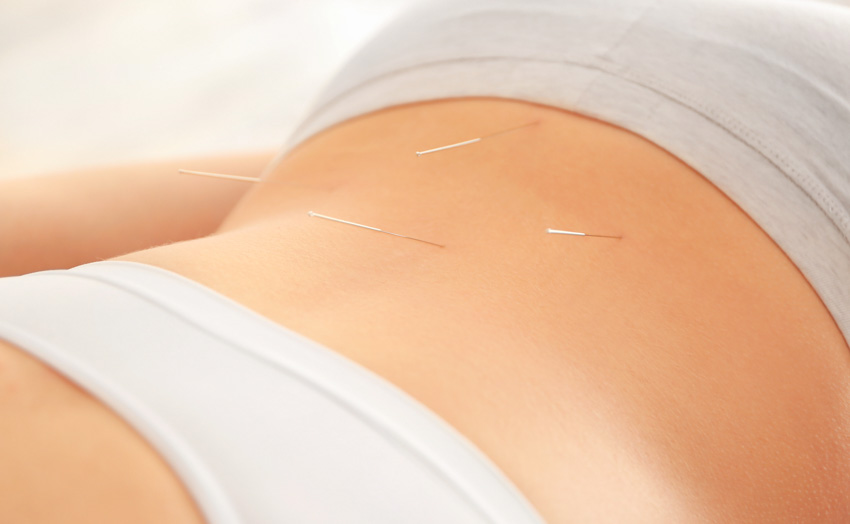
Acupuncture is effective for alleviating lumbar disc herniation pain and improves mobility. Researchers conclude that patients receiving acupuncture in an integrated treatment regimen have superior patient outcomes compared with patients solely receiving massage therapy or medications. Researchers note that stimulation of certain acupoints improves blood circulation and metabolism, thereby reducing neuritis (peripheral nerve inflammation) by activating qi and blood. [1] The results of two independent investigations demonstrate that acupuncture is an effective treatment modality for the treatment of lower back pain due to disc herniations.
In a study of 94 intervertebral lumbar disc herniation cases (Henan, China), acupuncture group results were superior to control group results. In the study, patients were randomly divided into two groups. The control group was comprised of 21 males and 26 females; patient age ranged from 35 to 68 years, with a mean age of 51.46 ±5.33. The acupuncture group was comprised of 25 males and 22 females; patient age ranged from 32 to 65 years, with a mean age of 50.74 ±5.26. Patients in both groups had a disease duration of one to five years prior to treatment. Both groups had patients with equivalent numbers of disc protrusions and extrusions (diagnosed by CT or MRI).
Both groups received tuina massage therapy. Patients took a supine position and therapists rolled their hands on the waist, hips, and legs for a duration of 10 to 15 minutes. Therapists applied pressure along the spine, bilaterally, using their thumbs. Next, a lateral position was adopted for the therapists to slightly bend the hips. After a 3-minute massage on both sides, patients rested on the bed and received a relaxing massage for another three minutes. Massage therapy was conducted daily. In the acupuncture treatment observation group, needles were inserted to the following acupoints using a twirling, lifting, and thrusting method:
- BL23 (Shenshu)
- GB30 (Huantiao)
- BL40 (Weizhong)
- SP6 (Sanyinjiao)
- BL37 (Yinmen)
- BL54 (Zhibian)
- GB34 (Yangling)
After obtaining a deqi sensation, moxa was attached at the end of the needles and then lit to ensure that patients felt a warm sensation on the acupuncture points. Warm needle treatment lasted for 25 minutes after obtaining deqi. Treatment was given daily for 30 days.
Observation indicators included the lumbar pain rating scale of the Japanese Orthopaedic Association (JOA) and the functional independence measurement scale (FIM). Following treatment, the acupuncture group demonstrated more significant improvements in all metrics for these two indicators. The TCM disease syndrome diagnosis curative effect standard for outcome measures consisted of three categories: significantly effective (waist and leg pain eliminated, legs can raise more than 70 degrees), effective (waist and leg pain alleviated, waist and leg function normalizing), ineffective (symptoms persisted or aggravated). The results show that 36 cases within the acupuncture group achieved the significantly effective level and 8 cases were effective, maintaining higher successful outcome rates at 93.62% compared with the tuina massage control group at 78.72%. [2]
In a similar study on 90 lumbar disc herniation cases, patients in the control group received medications including Fenbid (a brand name for ibuprofen: 0.3g/dose, twice a day), Jingfujang Yaotongning Capsules (1.2g/dose, twice a day), and Fufang Danshen Tablets (0.96g/dose, twice a day). The other 45 patients were treated with warming needle acupuncture and moxibustion on the local region of pain. Main acupoints used were the same as those in the aforementioned research. Patients received four 30-minutes sessions daily, and the entire course lasted for three weeks. A more significant amount of pain relief and quality of life improvement was recorded in the acupuncture group than the medication group. [3] The two studies indicate that acupuncture is an effective treatment modality for the relief of lumbar disc herniation related pain and dysfunction.
Notes:
[1] Wuxiao, Treatment of 90 Cases of lumbar herniation with warm acupuncture, Jiangxi Traditional Chinese Medicine 08 August 2020 Total 51 Vol .452.
[2] Wangtian, Clinical Observation on Treatment of lumbar Intervertebral Disc Herniationing Acupuncture and Massage, JOURNAL OF PRACTICAL TRADITIONAL CHINESE MEDICINE 2020.Vol.36 No.8.
[3] Wuxiao, Treatment of 90 Cases of lumbar herniation with warm acupuncture, Jiangxi Traditional Chinese Medicine 08 August 2020 Total 51 Vol .452.


